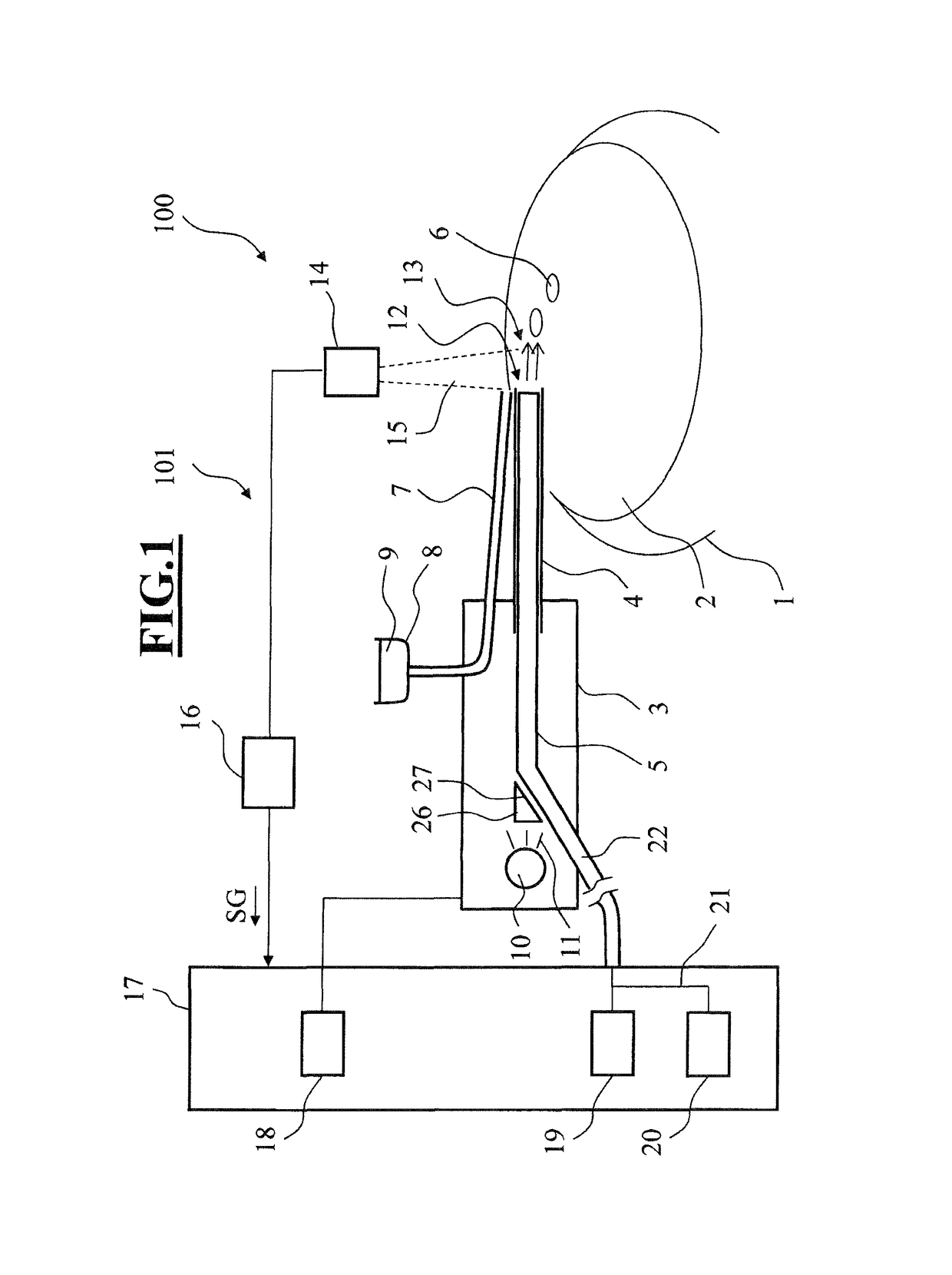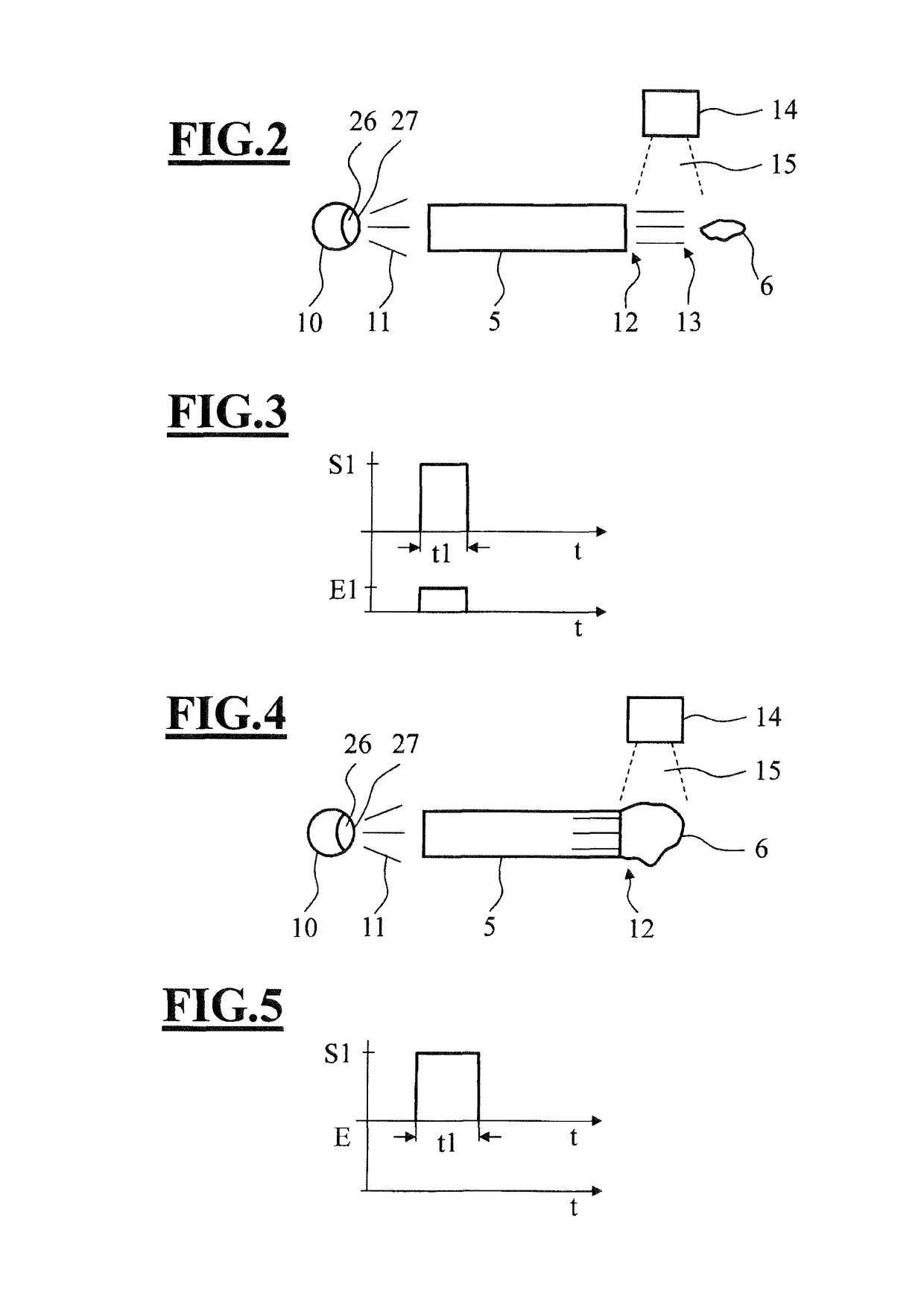Control arrangement for an ophthalmic surgical system
a control arrangement and ophthalmic surgery technology, applied in the field of control arrangement of ophthalmic surgery system, can solve the problems of unavoidable placement of particles, blockage of needle tip and/or suction opening, and relatively low complication rate, and achieve the effect of high efficiency and rapid and reliable detection
- Summary
- Abstract
- Description
- Claims
- Application Information
AI Technical Summary
Benefits of technology
Problems solved by technology
Method used
Image
Examples
first embodiment
[0042]In this first embodiment, a receiver 14 is arranged such that it can detect the electromagnetic radiation exiting at the distal end 12. For this purpose, the receiver 14 has a receiving region 15 which includes at least a zone about the distal end 12 of the aspiration line 5. The radiation received by the receiver 14 is processed so as to determine whether or not there is an occlusion, and whether an occlusion is beginning or just breaking through. The information is fed to a control unit 16 which outputs a control variable SG to a system component unit 17 as a function of the information.
[0043]The system component unit 17 can have a power supply 18 which is, in turn, connected to the phaco handpiece 3. When it has been established by means of the receiver 14 that a breakthrough of an occlusion has taken place, the control unit 16 can drive the power supply 18 such that the needle 4 is no longer excited to ultrasonic vibrations. It follows that there is no further supply of po...
third embodiment
[0054]In the embodiment illustrated in FIG. 7, a single coupling element 26 is used in order to couple electromagnetic radiation 11 into the aspiration line and decouple reflected radiation 25 from the aspiration line 5 to the receiver 14. In the third embodiment, illustrated in FIG. 8, of a control arrangement 301 of an ophthalmic surgical system 300, a receiver 14, which can be arranged near the transmitter 10, receives at least a portion of the radiation 25 reflected by the lens particles 6 by means of a second coupling device 260 separated from the coupling device 26.
fourth embodiment
[0055]FIG. 16 is a schematic of a control arrangement 401, according to the invention, of an ophthalmic surgical system 400. Here, the coupling device 26 can be configured such that only the electromagnetic radiation emitted by the transmitter 10 is passed on by means of the coupling device 26 and coupled into the aspiration line 5 via the distal end 27. The radiation 25 reflected by the lens particles 6 penetrates into the aspiration line 5 and is detected directly by the receiver 14 without a coupling device being arranged upstream thereof. This is advantageous when all that is still incident at the receiver is a reflected radiation 25 with a very low beam intensity, since as a result no further component can continue to weaken the beam intensity of the incident radiation 25.
[0056]Associated signal profiles for the situation in accordance with FIG. 8 are illustrated schematically in FIG. 9. A transmitter 10 emits an electromagnetic radiation with a signal strength S1 during a time...
PUM
 Login to View More
Login to View More Abstract
Description
Claims
Application Information
 Login to View More
Login to View More - R&D
- Intellectual Property
- Life Sciences
- Materials
- Tech Scout
- Unparalleled Data Quality
- Higher Quality Content
- 60% Fewer Hallucinations
Browse by: Latest US Patents, China's latest patents, Technical Efficacy Thesaurus, Application Domain, Technology Topic, Popular Technical Reports.
© 2025 PatSnap. All rights reserved.Legal|Privacy policy|Modern Slavery Act Transparency Statement|Sitemap|About US| Contact US: help@patsnap.com



